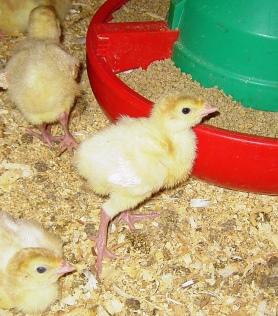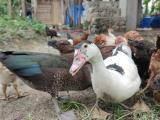With a respite from H5N2 avian influenza outbreaks in the Midwest continuing, officials say it's too early to declare the crisis over for the summer, but hopes are rising as more poultry farms resume operating.
Meanwhile, Minnesota researchers have found some further evidence suggesting that the H5N2 virus may be able to spread by air, and congressional leaders this week asked the Obama administration for information about risks posed by H5N2, including its impact on the supply of eggs needed to produce flu vaccines.
The two hardest-hit states, Iowa and Minnesota, have now gone 2 weeks and almost 4 weeks, respectively, without any new poultry outbreaks. Officials expected that the situation would improve in the summer, when the weather is less favorable for the virus, but they also have warned that outbreaks could return in the fall.
"I can't say for sure whether the outbreak is over for the summer," Bethany Hahn, spokeswoman for the Minnesota Board of Animal Health (MBAH), said today. "Iowa had another case a couple of weeks back. What I will say is that it's been almost 4 weeks since we've had another positive flock in Minnesota, and we hope that trend continues."
More farms restocking
She said 14 of the 108 affected farms in the state have signed restocking agreements, meaning they are cleared for restocking or have already done so. In addition, 17 control areas around infected farms have been released from quarantine, the MBAH reports.
In Iowa, which has lost more than 31 million birds, mostly chickens, to avian flu and resulting culling, Gov. Terry Branstad this week extended his disaster emergency declaration through the end of July. It was his second extension of the declaration, which facilitates the use of all state resources in the response.
In its latest update, on Jun 26, the Iowa Department of Agriculture and Land Stewardship (IDALS) said all infected poultry farms had been depopulated and that cleaning and disinfection were under way in many of them. The update didn't say whether any farms were restocking yet.
In neighboring northeastern Nebraska, five commercial chicken farms and a backyard poultry flock were all depopulated by the end of last week, the Nebraska Department of Agriculture reported on Jun 26. The commercial farms, located in Dixon County, had a total of 4.9 million laying hens and pullets.
Other Midwestern states hit by H5N2 outbreaks this year, including South Dakota, North Dakota, and Wisconsin, have gone longer than Minnesota and Iowa without any new detections.
Viable virus found outside poultry barn
In a related development, a University of Minnesota researcher said she and her colleagues recovered viable H5N2 virus from air samples taken right outside a Nebraska chicken barn, providing some additional support for the notion that the virus can spread by air.
Montse Torremorell, DVM, PhD, reported several weeks ago that her team found viable H5N2 virus particles in air samples taken inside an infected turkey barn in Minnesota. Now, she told CIDRAP News, live virus has been identified in air samples collected inside and immediately outside a Nebraska facility housing infected layer chickens.
Air samples collected farther away from infected facilities have not yielded any viable virus samples, Torremorell said. She holds the university's Allen D. Leman Chair in Swine Health and Productivity.
Exactly how the H5N2 virus spreads from farm to farm has been unclear. The US Department of Agriculture (USDA) believes that infected wild birds brought the virus to the Midwest initially, but that other factors are probably involved on the local level. In a report issued Jun 15, the agency said it couldn't pinpoint any one factor causing local transmission, but concluded that the explanation probably lies in biosecurity lapses, possibly augmented by airborne transmission.
The air sampling studies by Torremorell and several colleagues were sponsored by the USDA, and some of their preliminary findings were noted in the agency report.
Lawmakers seek information on risks
In still other news, leaders of the US House Energy and Commerce Committee asked the Department of Health and Human Services (HHS) this week for information on the risks posed by highly pathogenic avian influenza (HPAI) and the agency's preparedness for such risks.
The letter, addressed to Nicole Lurie, MD, MPH, head of HHS's Office of the Assistant Secretary for Preparedness and Response (ASPR), was signed by Committee Chairman Fred Upton, R-Mich.; ranking member Frank Pallone Jr., D-N.J.; Tim Murphy, R-Pa., chair of the Oversight and Investigations Subcommittee; and Diane DeGette, D-Colo., ranking member of the Oversight and Investigations Subcommittee.
The lawmakers asked what steps ASPR has taken "to ensure the flu vaccine supply, still largely reliant on chicken eggs for manufacturing, is protected against the spread of HPAI H5 [H5N2 and H5N8] viruses."
They also asked whether Lurie's office has formally assessed the risk of H5 infections in humans and the capacity of the US public health system to respond to that eventuality, and they inquired about efforts to develop vaccines for the viruses. (No human infections with the H5N2 or H5N8 viruses have been reported in the United States.)
The four Congress members also wrote a letter to the Government Accountability Office seeking a review of federal preparedness efforts for avian flu, including measures to ensure that the poultry industry's biosecurity efforts are adequate.
See also:
Jun 29 Branstad press release on disaster extension
Jun 26 IDALS update on avian flu
Jun 26 Nebraska press release
Jun 29 Congress members' letter to Lurie
Jun 29 House Energy and Commerce Committee press release
Related Jun 15 CIDRAP News story on USDA H5N2 epidemiologic study
Jun 26 CIDRAP News item on H5N2 lull





















